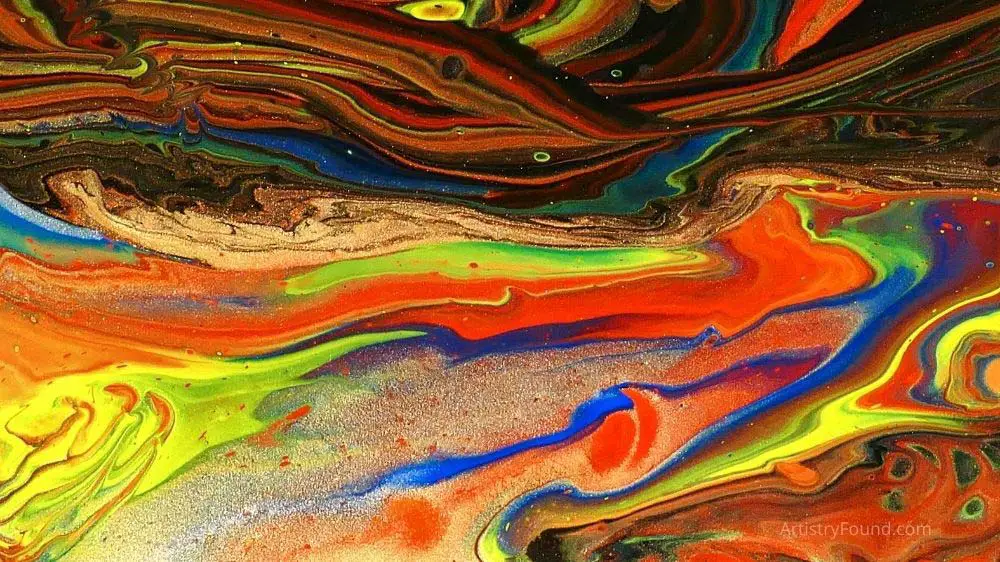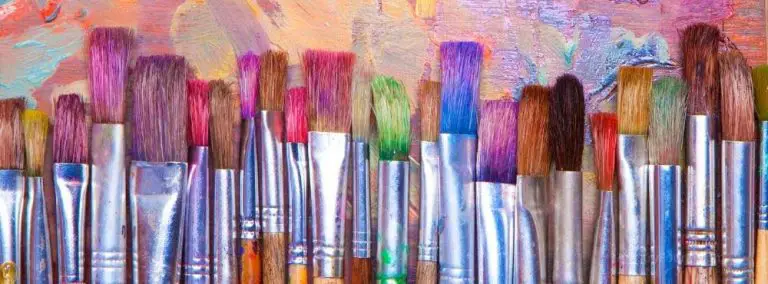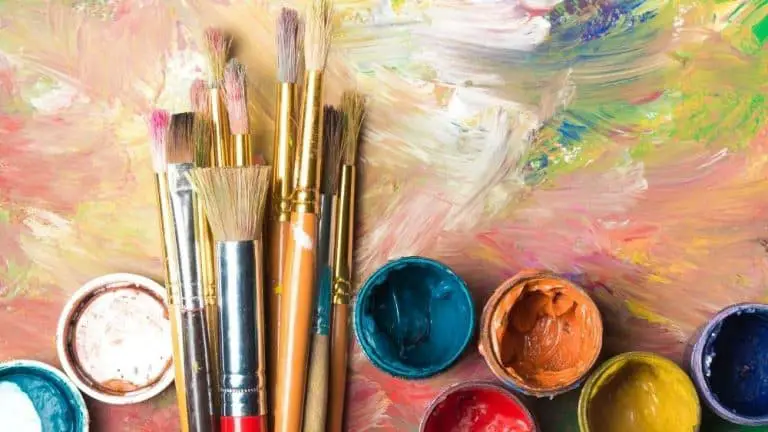Is Acrylic Pouring Expensive? (Let’s break it down)
If you’ve seen an abstract painting created through the acrylic pour painting process, then you know just how cool these paintings are and perhaps you’re wanting to give it a try yourself. If that’s the case, then you need to know that acrylic pouring can be an expensive type of art to create. So why is that? Let’s break it down.
On average, the cost of creating a medium-sized acrylic pour painting will be around $32. The expense can easily be increased to $50 or more if adding special effects. However, you can keep the cost of acrylic pouring down by using cheaper materials and re-using old canvases and paint.
In this article, I detail the overall costs of acrylic pouring, talk about some of the tools required, and list some tips and tricks to make paint pouring more affordable.

(This article may contain affiliate links and I may earn a commission if you make a purchase)
The Cost of Acrylic Pouring
First, you will need some specific materials when using this fluid painting technique.
The following are the supplies and tools that you will want to include in the overall cost of creating a pour painting:
- The most critical and expensive aspect of creating this type of painting is the acrylic paint itself.
- You will need a pouring medium to be able to pour your acrylic paint. And you need other additives to give your art some special effects.
- Also, you’ll need to add a canvas panel to your list of materials for creating your art.
- Pouring cups with mixing sticks is essential for mixing your paints and pouring the paint onto your canvas. Also, squeeze bottles can come in handy.
- Don’t forget the torch or heat gun if you want to create cells in your acrylic pouring and pop those air bubbles.
- Oh, and you want to include a tarp or other protective surface because this type of artmaking will get messy.
Let’s break down the cost of each one of the above items.
The Cost of Acrylic Paint
There is no exact price for how much acrylic paint is.
The expense of acrylic paint depends on the amount of paint, its brand, the colors you choose, and where you buy it.
The cost can be anywhere from $1 to $6 for two to eight-ounce tubes. A gallon of acrylic paint can cost about $25 to $45.
Also, be aware that buying a set of acrylic paints with different colors will be cheaper than buying them individually.
And buying acrylic paint in gallons will also be cheaper in its comparative price.
The Cost of the Additives
Pouring mediums are crucial when using the acrylic pouring technique.
A paint additive or medium will help improve the flow of the paint.
However, there are other options out there as well. For example, you could instead use Floetrol or PVA Glue (both found at Amazon) as a cheaper alternative.
You will need more pouring medium than acrylic paint, so you will need a lot more of this than the paint itself.
It usually goes like this: One part of paint to three parts of pouring medium.
Pouring medium usually costs about $25 for around 17 ounces on Amazon.
Floetrol is cheaper and costs $8 for 32 ounces.
Other additives like silicone oil, RainX, Coconut Milk serum, and dish soap will create the cool cell effect. If you want to create cells, you will need to consider these additives when determining your expenses.
The Cost of Acrylic Pouring Tools
You will need many different tools when doing acrylic pouring, and all of these have different prices.
Unfortunately, I can’t tell you exactly what the prices are because there are just so many different options for you to choose from.
But here are some estimated costs:
- Canvas or wooden panels – You can find white stretched canvas boards in packs of 10 anywhere between $10 to $30 on amazon. And the bigger the pack of different sized canvases, the cheaper the price becomes. Wooden panels are more expensive but give you a steadier painting surface to work on. I have found all kinds of options on amazon, from 6-pack wooden panels for $17 to a 2-pack for $55. The prices for wooden panels all depend on their quality and size.
- Pouring cups with mixing sticks and squeeze bottles – Again, prices vary depending on what quality you are looking for. But to give you an idea of what prices you can expect, I have found six squeeze bottles for $10 on Amazon that will do the work. And you can even find 80 plastic pouring cups, including 80 wooden mixing sticks, for $17 on amazon too. But if you are looking for fancier cups with dividers, you can spend up to $35 for one cup.
- Torch or heat gun – You can get away with buying a good-quality torch for no more than $18 if you want. Again, there are more expensive and cheaper options, but $18 seems to be average. A heat gun does the same thing but without an open flame and is a good alternative. You can find a heat gun for $19 to $50 on amazon.
- Protective surface – This layer to protect your surface can be anything from old newspapers to 12-foot plastic drop cloths for around $3 on amazon.

The Total Cost of Acrylic Pouring
Okay, we have established all the individual prices of the supplies you will need to do acrylic pouring.
Let me now give you an average example of how much acrylic pouring can cost if you include everything you need.
If you want to acrylic pour on an 18’’x24″ canvas, you will need about 22 ounces of paint mixed with a pouring medium.
That’s 5.5 ounces of acrylic paint with 16.5 ounces of pouring medium.
This will cost around $26. Then add a wooden canvas for $3 and 3-4 pouring cups with mixing sticks for $3 and a free newspaper for protecting surfaces to the cost.
So now you are up to a cost of $32 for each acrylic pouring you create.
Adding the mediums to create cells can add $5 in cost, and for that, you also need a torch for $18.
So after buying a new torch, you can count on spending $55 in total cost creating that first acrylic pouring piece.
Remember that this total cost of $55 is just one example of how much acrylic pouring costs.
It is no secret that this is an expensive art technique!
Saving Money on Acrylic Pouring
Fortunately, there are some ways of making acrylic pouring more affordable.
I have put together some tips on how you can keep the costs down.
Examples of how you can save money on acrylic painting
- Look for sales, coupons, or special promotions. Being flexible with when you buy your material can save you some money.
- Buy gallons of colors or pouring mediums instead of buying the small bottles.
- Go for sets of colors if you aren’t picky with your colors. The sets are usually cheaper than buying colors individually.
- Settle for student-grade acrylic paints since these are cheaper than artist-grade paints. Not having the best quality can be good for when you are still experimenting and learning about acrylic pouring.
- Collect your run-off paints and re-use them. You can tilt your canvas board and let the paint run from its edges into a cup again and use it for later. The same tactic goes for mixing sticks and cups. Scrape the paint off and use it again. Try to save the cups and sticks too, and you won’t need to buy new ones regularly.
- You can re-use canvases. If you weren’t happy with one design, re-use the same canvas and try again!
- Search for cheaper alternatives. For example, instead of buying Liquitex pouring medium, go for the more affordable option of Floetrol. The same goes for the additives that create cells. Use dish soap that you have at home instead of buying silicone oil, for example.
- Last but not least, try to instead make money on your acrylic pouring by selling your art. This is probably your best option for keeping the cost of your pour painting down.
Conclusion
After breaking down the total cost, you can see why acrylic pouring can be expensive.
However, we have also discovered alternative products and ways of acrylic pouring to make this fluid art more affordable.
Spending $32 on every medium-sized acrylic pouring piece is not possible for every artist out there.
That is why re-using products, buying cheaper supplies, and selling art pieces from time to time really helps to keep the costs down.
Related Articles:
- Artist’s Loft Acrylic Paint Review (Are They Any Good?)
- Should Artists Date Their Paintings? (What You Need to Know)
- Should I Sell My Original Paintings Or Just Prints? (Explained!)
References:
https://www.pinterest.com/gailpottinger/acrylic-pour-painting/






